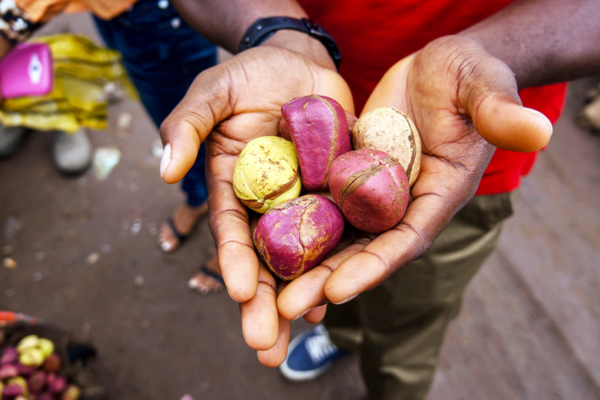NIGERIA
Kola Nuts and the Science of Connection
By Uchenna Emenaha Miles
San Antonio, TX, United States
As guests arrive at the house, the host welcomes each one with a cheerful “Nnọọ!” (nn-ah), an Igbo word for “welcome.” Smiles and nods are exchanged as the guests settle into their seats, already feeling right at home. Then the bride’s father, an older gentleman named Leonard (pictured in the red shirt at right), stands up. In his hands, he holds a platter filled with kola nuts. Family members gather around him to receive the nut once it has been blessed.
As the eldest man at the gathering, Leonard has a special role in saying the official blessing over the kola nut. Everyone listens closely as he lifts the nuts and offers words of welcome and hope.
In Igbo culture, the kola nut, called ọjị (o-jee), is much more than a snack. It’s a powerful symbol of unity, hospitality, and community. While the kola nut is respected by many groups in Nigeria, it holds especially deep meaning for the Igbo people. Igbo oral tradition says that the kola tree was the very first tree on Earth. Because of this significance, the nut is used in rituals and important celebrations.
Kola Nuts in Nigerian Ceremonies
The kola nut is typically presented at the beginning of big events, like weddings, baby-naming ceremonies, and the ordination of leaders. The occasion determines the nut’s symbolic meaning.
For example, at weddings, the bride’s family offers the kola nut to the groom’s family as a beautiful emblem of unity and love. At other times, sharing the kola nut welcomes guests and pays respect to ancestors who have come before.

Photo courtesy of the author
A Wedding Story
At the beginning of a wedding ceremony, the bride’s family carefully presents the kola nut to the groom’s family. An elder from the bride’s side stands to bless the nut. After the blessing, the elder breaks the kola nut into sections, using strong hands to make clean splits. Each section is then passed around, piece by piece, to the guests.
As people receive their share, they smile and say words of thanks. Sharing the kola nut brings everyone closer, weaving a sense of unity and love throughout the celebration.
The ceremony has three important steps: preparing, blessing and breaking, and sharing the kola nut.
- Preparing means choosing the perfect nut: fresh, whole, and without any cracks.
- Blessing and breaking are special, too. Only an elder can perform this part of the ritual, speaking the blessing in the Igbo language. As the saying goes, “The kola nut does not speak English.”
- Sharing the nut brings everyone together, making sure each guest feels included in the celebration.

Photo courtesy of the author
Science and Other Uses
Beyond celebrations, the kola nut is famous for its natural boost of energy, as it’s packed with caffeine! In fact, the early recipe for Coca-Cola even used kola nuts. Nigerians have long known the nut’s power. It helps with stress, acts as an appetite suppressant, and has even been used to make medicines.
Burning kola nuts along with other plants creates healing smoke that can ease headaches and stomach pain. People also use kola nuts to make products like liquid detergent and kola wine. It’s a nut with a lot of science inside!
Farming and the Future
Nigeria grows about 53 percent of the world’s kola nuts—that’s around 174,000 metric tons every year! Kola farming is an important way for families to earn money and support their communities.
But recently, farmers have noticed a problem. Many kola trees are getting old or unhealthy, and harvests are shrinking. To address this, collaborative efforts are underway among farmers, scientists, and government leaders in areas like Nkume (an Igbo community).
Using modern techniques like grafting, they’ve been able to grow healthy kola trees that produce fruit in just three years. In the past, growers had to wait seven years for the trees to bear fruit. These improvements offer hope for supporting future generations of growers.

Fruit of the kola tree. Photo credit: Scamperdale via Flickr
A Growing Legacy
The kola nut isn’t just a plant. For the Igbo people, it’s a symbol of life, unity, and connection. This small but powerful nut plays a key role in ceremonies, medicine, farming, and everyday life.
The kola nut’s legacy as a symbol of unity and tradition will continue to thrive, enriching the cultural heritage of Nigeria. As the country works to protect and strengthen its farms, this special crop’s significance will continue to grow, carrying its story into the future.
Have a suggestion for this story? We’d love for you to submit it!


Blank
Blank
Math Resources
Sample Problems:
- If Nigerian farmers produce 174,000 metric tons of kola nuts, and they ship out 10 percent each year, how much gets exported?
- If a wedding has 100 guests and each kola nut can be divided into four pieces, how many kola nuts are needed to give everyone a piece?
- If kola nut production increases by 10 percent each year, what would be the average yearly production after five years?
- If one kola nut weighs about 30 grams, how many kola nuts are in one metric ton?
- In the past, a kola tree took seven years to bear fruit. Thanks to grafting, it now takes just three years. Over a 21-year period, how many more harvests could a farmer get from a grafted tree than from a traditional one?
- Suppose a farmer earns 0.75 US dollars for every kilogram of kola nuts sold. If a harvest produces 2.5 metric tons in a year, how much money would the farmer make? How would the income change if the harvest increased by 20 percent the following year?
Social Justice Question
Kola farming is important for many families and communities in Nigeria, but old and unhealthy trees have caused harvests to shrink. Who should take responsibility for saving the kola farms: the growers, the government, or both? Explain your reasoning.
Explore Further
- More information about the meaning of kola nuts in Igbo culture
- Collection of photo stories about kola nuts
- More details about the role of kola nuts in weddings
- Nigeria’s kola research institute
- Behind-the-scenes look at kola nut production
Share Your Story
Write your own Global Math Story and send it to us!
Sorry, the comment form is closed at this time.